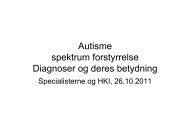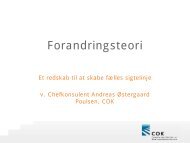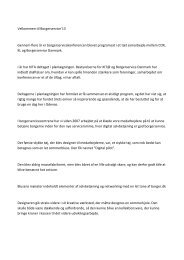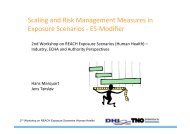11-13 May 2012 Helsingør - Denmark www.networkbio.org
11-13 May 2012 Helsingør - Denmark www.networkbio.org
11-13 May 2012 Helsingør - Denmark www.networkbio.org
You also want an ePaper? Increase the reach of your titles
YUMPU automatically turns print PDFs into web optimized ePapers that Google loves.
RUNE LINDING<br />
DTU, LYNGBY - DENMARK<br />
abStract For SPeakerS<br />
Dr Rune Linding is Professor and Research Group Leader for the Cellular Signal<br />
Integration Group (C-SIG) at the Technical University of <strong>Denmark</strong> (DTU),<br />
Center for Biological Sequence Analysis (CBS), Department of Systems Biology,<br />
<strong>Denmark</strong>. He performed his graduate work at the EMBL (Germany), where<br />
he pioneered computational analysis of cell signaling by developing popular<br />
tools like ELM, GlobPlot and DisEMBL for analysing post-translational modifications,<br />
intrinsic protein disorder and modularity of signaling proteins. Dr<br />
Linding was Human Frontiers Science Program Postdoctoral Research Fellow<br />
jointly with Profs Tony Pawson and Mike Yaffe at Samuel Lunenfeld Research<br />
Institute (SLRI, Canada) and Massachusetts Institute of Technology (MIT,<br />
USA), respectively. His postdoctoral work on the cellular phosphorylation networks and development of the<br />
NetworKIN algorithm pioneered Integrative Network Biology and led to the discovery of the quantitative<br />
importance of contextual kinase specificity. He started his own lab (the Cellular & Molecular Logic Team)<br />
at The Institute of Cancer Research (ICR) in London in 2007. At ICR his lab unravelled systems-level models<br />
of JNK and EphR kinase networks, demonstrated a link between specificity and oncogenecity of kinases<br />
and introduced the concept of Network Medicine. Dr Linding leads the NetPhorest community resource<br />
and have pioneered comparative phospho-proteomics and evolutionary studies of signalling networks. Dr<br />
Linding founded the Integrative Network Biology initiative (INBi) which aims to block cancer metastasis by<br />
integration of large-scale, high-dimensional quantitative genomic, proteomic and phenotypic data. His lab<br />
moved to DTU/<strong>Denmark</strong> in 20<strong>11</strong> and the long-term focus of his research group is on studying cellular signal<br />
processing and decision making.<br />
Modeling of Cancer Kinome Networks<br />
Abstract: Biological systems are composed of highly dynamic and interconnected molecular networks that<br />
drive biological decision processes. A goal of integrative network biology is to describe, quantify and predict<br />
the information flow and functional behaviour of living systems in a formal language and with an accuracy<br />
that parallels our characterisation of other physical systems such as Jumbo-jets. Decades of targeted<br />
molecular and biological studies have led to numerous pathway models of developmental and disease<br />
related processes. However, so far no global models have been derived from pathways, capable of predicting<br />
cellular trajectories in time, space or disease. The development of high-throughput methodologies has<br />
further enhanced our ability to obtain quantitative genomic, proteomic and phenotypic readouts for many<br />
genes/proteins simultaneously. Here, I will discuss how it is now possible to derive network models through<br />
computational integration of systematic, large-scale, high-dimensional quantitative data sets. I will review<br />
our latest advances in methods for exploring phosphorylation networks. In particular I will discuss how the<br />
combination of quantitative mass-spectrometry, systems-genetics and computational algorithms (NetworKIN<br />
[1] and NetPhorest [4]) made it possible for us to derive systems-level models of JNK and EphR signalling<br />
networks [2,3]. I shall discuss work we have done in comparative phospho-proteomics and network<br />
evolution[5-7]. Finally, I will discuss our most recent work in analysing genomic sequencing data from NGS<br />
studies and how we have developed new powerful algorithms to predict the impact of disease mutations on<br />
cellular signaling networks and applied them to profiling of ovarian cancer cells.<br />
References:<br />
http://<strong>www</strong>.lindinglab.<strong>org</strong><br />
Linding et al., Cell 2007.<br />
Bakal et al., Science 2008.<br />
Jørgensen et al., Science 2009.<br />
Miller et al., Science Signaling 2008.<br />
Tan et al., Science Signaling 2009.<br />
abStract For SPeakerS<br />
GIANNI CESARENI<br />
Mapping the human phosphatome on growth pathways<br />
fRANCESCA SACCO 1<br />
, PIER fEDERICO GhERARDINI 1<br />
, SERENA PAOLUzI 1<br />
, JULIO SAEz-RODRIGUEz 3<br />
,<br />
MANUELA hELMER-CITTERICh 1<br />
, ANTONELLA RAGNINI-WILSON 1,2<br />
, LUISA CASTAGNOLI 1<br />
AND GIANNI<br />
6 / INB <strong>2012</strong> • <strong>11</strong>-<strong>13</strong> <strong>May</strong> <strong>2012</strong> <strong>www</strong>.<strong>networkbio</strong>.<strong>org</strong> / 7<br />
CESARENI 1<br />
1<br />
DEPARTMENT Of BIOLOGY, UNIVERSITY Of ROME “TOR VERGATA”, ITALY 2hIGh-ThROUGhPUT MICROS-<br />
COPY fACILITY; DEPARTMENT Of TRANSLATIONAL AND CELLULARPhARMACOLOGY, CONSORzIO MARIO<br />
NEGRI SUD, SM. IMBARO, ITALY 3EMBL-EBI, hINxTON, UK AND EMBL-GENOME BIOLOGY UNIT, hEIDEL-<br />
BERG, GERMANY<br />
Large-scale siRNA screenings allow linking the function of poorly characterized genes to phenotypic<br />
readouts. According to this strategy, genes are associated to a function of interest if the alteration of their<br />
expression perturbs the phenotypic readouts. However, given the intricacy of the cell regulatory network, the<br />
mapping procedure is low resolution and the resulting models provide little mechanistic insights. We have<br />
developed a new strategy that combines high-content multiparametric analysis of cell perturbation and logic<br />
modeling to achieve a more detailed functional mapping of human genes onto complex pathways. By this

















